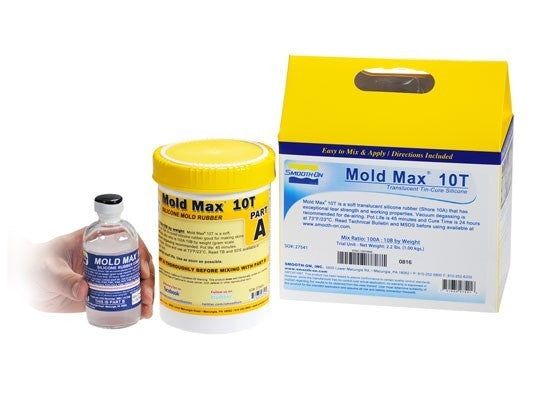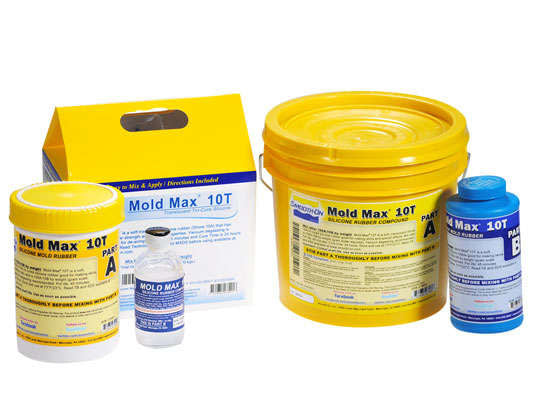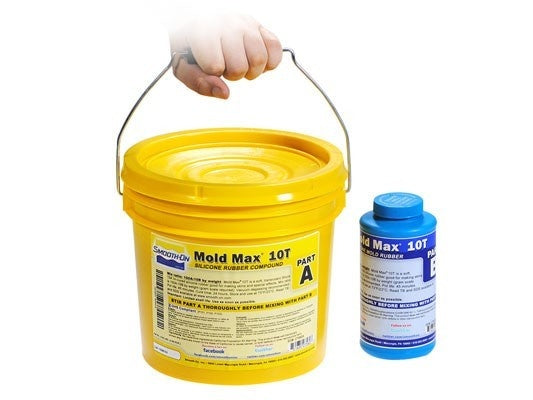Smooth-On
Mold Max™ 10T Special Order
Mold Max™ 10T Special Order
4 in stock
Couldn't load pickup availability
PLEASE CALL US TO ORDER
Mold Max™ 10T silicone is a water white translucent tin cured silicone rubber compound that has exceptional tear strength and working properties. It features Smooth-On’s “Libra™” catalyst for long library life. Mixed 100A:10B by weight, vacuum degassing is recommended for de-airing. Rubber cures overnight at room temperature. Mold Max™ ‘T’ silicones can be thickened with Thi‑Vex™ thickener for brush-on application and effects.

Features
- Similar in appearance to Smooth-On’s premium Dragon Skin™ platinum silicones
- Mold Max™ ‘T’ silicones are a less costly alternative for creating animatronic skin effects.
- An infinite number of color effects can be achieved by adding Silc Pig™ silicone pigments or Cast Magic™ effects powders.
Instructions
Important: you must weigh Part A & B components using a gram scale to be successful with Mold Max™ 10T.
NOTE: Mold Max™ ‘T’ series silicones should NOT be used to make molds for casting Crystal Clear™ or Clear Flex™ Series urethanes.
Because no two applications are quite the same, a small test application to determine suitability for your project is recommended if performance of this material is in question.
Safety – Use in a properly ventilated area (“room size” ventilation). Wear safety glasses, long sleeves and rubber gloves to minimize contamination risk. Wear vinyl gloves only. Latex gloves will inhibit the cure of the rubber.
Store and use material at room temperature (73°F/23°C). Storing material at warmer temperatures will also reduce the usable shelf life of unused material. These products have a limited shelf life and should be used as soon as possible.
Applying a Sealer / Release Agent - Mold Max™ rubber may be inhibited by sulfur based clays resulting in tackiness at the pattern interface or a total lack of cure throughout the mold. If compatibility between the rubber and the surface is a concern, a small-scale test is recommended. Apply a small amount of rubber onto a non-critical area of the pattern. Inhibition has occurred if the rubber is gummy or uncured after the recommended cure time has passed. To prevent inhibition, a “barrier coat” of clear acrylic lacquer sprayed directly onto the pattern is usually effective. Allow to thoroughly dry.
Although not usually necessary, a release agent will make demolding easier when pouring into or over most surfaces. Ease Release™ 200 is a proven release agent for making molds with silicone rubber and for releasing new silicone from cured silicone. Mann Ease Release™ products are available from Smooth-On or your Smooth-On distributor.
Measuring & Mixing - Before you begin, pre-mix Part B thoroughly to re-disperse pigments that may have settled. Using a gram scale, dispense required amounts of parts A and B into a mixing container and mix for 3 minutes. Scrape the sides and bottom of the container several times. After mixing parts A and B, vacuum degassing is recommended to eliminate any entrapped air in liquid rubber. Your vacuum pump must pull a minimum of 29 inches of mercury (or 1 Bar / 100 KPa). Leave enough room in container for material expansion. Vacuum material until it rises, breaks and falls. Vacuum for 1 minute after material falls.
Pouring / Curing / Post Curing - For best results, pour your mixture in a single spot at the lowest point of the containment field. Let the rubber seek its level up and over the model. A uniform flow will help minimize entrapped air. The liquid rubber should level off at least 1/2” (1.3 cm) over the highest point of the model surface. Allow the mold to cure overnight (at least 16 hrs) at room temperature (73°F/23°C) before demolding. Post curing the mold an additional 4 hours at 150°F (65°C) will eliminate any residual moisture and alcohol that is a byproduct of the condensation reaction that can inhibit the cure of some urethane resins and rubbers. Allow mold to cool to room temperature before using. Do not cure rubber where temperature is less than 65°F/18°C.
Thickening Mold Max™ Silicones For Brush-on Application - THI-VEX™ is made especially for thickening Smooth-On’s Mold Max™ 10T silicone for vertical surface application (making brush-on molds). Different viscosities can be attained by varying the amount of THI-VEX™. Apply a thin coat of rubber. Wait for rubber to become “tacky” before applying next coat. Final mold thickness should be at least 3/8” (1 cm). Allow rubber to cure overnight before applying support shell. See the THI-VEX™ technical bulletin (available from Smooth-On or your SmoothOn distributor) for full details.
Accelerating Mold Max™ Silicones - Accel-T™ Silicone Rubber Accelerator will accelerate the cure time of Mold Max™ silicone rubbers. Accel-T™ can be used with Mold Max™ 10T. Note: working time is reduced in proportion to the amount of Accel-T™ added. See the technical bulletin for Accel-T™ (available from Smooth-On or your Smooth-On distributor) for exact mix ratios and cure times. Using these accelerators will result in a shorter library life of the mold.
Thinning Mold Max™ Silicones - Silicone Thinner™ is a non-reactive silicone fluid that will lower the mixed viscosity of tin cure (condensation) or platinum cure (addition) silicone rubber products. Silicone Thinner™ offers the following advantages: [1] A lower mixed viscosity (A+B) means that the rubber will de-air faster when vacuuming; [2] Mixed rubber (A+B) will flow better over intricate model detail; [3] Silicone Thinner™ will lower the ultimate shore hardness (durometer) of cured silicone rubber; [4] Pot life (working time) is increased in proportion to the amount of Silicone Thinner™ used. A disadvantage is that ultimate tear and tensile are reduced in proportion to the amount of Silicone Thinner™ added, however knotty tear properties of the Mold Max™ Series rubbers are unaffected. It is not recommended to exceed 10% by weight of total system (A+B).
Mold Performance & Storage - The physical life of the mold depends on how you use it (materials cast, frequency, etc.). Casting abrasive materials such as concrete can quickly erode mold detail, while casting non-abrasive materials (wax) will not affect mold detail. Before storing, the mold should be cleaned with a soap solution and wiped fully dry. Two part (or more) molds should be assembled. Molds should be stored on a level surface in a cool, dry environment.
Share



- Choosing a selection results in a full page refresh.
- Opens in a new window.


